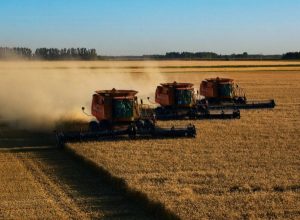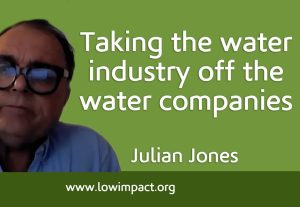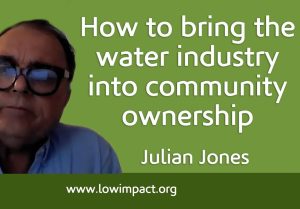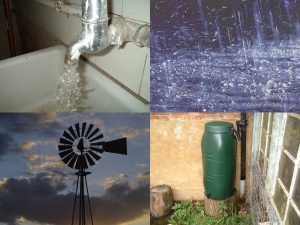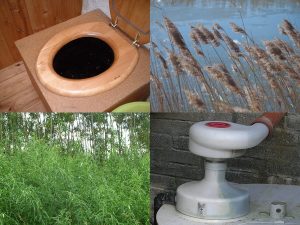Water is the ubiquitous precondition for life on Earth. The great hydrological cycle, which passes through us, as much as through any river, cloud, or ocean, encompasses the living soil, plants and animals. The Gaian system is one, unified, watery, cycle. Water is essential to the functioning of our bodies, and to linking all living systems.
Water ties humans into networks of responsibility and vulnerability. The dendritic flow of water, from the smallest scale to the widest landscape is daily taken for granted: broken; engineered, misunderstood, commercialised and despoiled. As individuals, living oblivious, in the stream, we can never fully control the water which comes to us, or guarantee the fate the water which leaves us after we have used it. We rely on wider society, on our ecosystems, and on the whole of the Earth system. The hydro-social cycle (Ballestero, The Anthropology of Water, 2019).
As Bill Moillison reminds us (Permaculture, Bill Mollison, 1990, P152), very little of the Earth’s water is readily available to meet human needs. The hydrological cycle has been massively disturbed, and today, we face not only the challenge of climate breakdown, but also of breaking through multiple planetary system boundaries (https://www.stockholmresilience.org/research/planetary-boundaries.html). Our societies function inside surprisingly narrow limits.
In Cymru, we can expect drier summers and wetter winters, and this is going to happen as living systems – rivers, the soil and the seas – face breakdown. The continuation of organised human society depends upon our preparation for, and adaptation to these new realities. So novel are these challenges that they are very little understood in public discourse.
We must shift from seeing water as solely a political issue, related to the destruction of historical communities, resource extraction and arrested development, to being able to understand water in the context of landscape watersheds, bioregions, and communities, both natural and human. Moving from thinking about water and structures, to thinking about water and living systems.
Challenging times demand new political forms and profound cultural change, a different way of seeing, one which goes beyond a “resource” model, to an understanding of where our water comes from, how it flows, and how we must interact with it. Only by forging direct connections between communities old and new, and their ecological life support systems can we come to understand that these systems, and our communities, together, constitute our real common wealth. In uncertain times, it is ecological systems which will meet the needs of localities and of the communities within them.
Historically, communities arise in relationship to watersheds, the rivers and springs which arise from them, but we live in a time of weakened communities, pulled apart by the vagaries of modern economics and social change. We habitually mistake proximity for community, or local government for community, and then use the term as a catch-all, stripped of all meaning, a feel-good word, thrown into the breach. Here, we will understand community as a matrix of mutuality and familiarity, indispensable to the satisfactory meeting of human needs.
Strategies on Several Scales
The widest public understanding of strategies for living responsibly with water relates to the household level. The threat of a “hosepipe ban” being handed down, or calls to save water are familiar to most of us. For those people who take their own relationship to water more seriously, measures often start and finish with the use of rain butts for the garden.

There are in fact many more measures which might be taken by individual households. Rainwater harvesting for both domestic and garden use is an obvious first step. (Essential Rainwater Harvesting: a guide to home-scale system design by Rob Avis & Michelle Avis, 2018) We might also consider reducing hard landscaping to a minimum to encourage water infiltration; the use of water efficient appliances, a transition to composting loos, and grey water systems for garden and tree irrigation.
Truthfully though, like so many ‘Green’ measures, the household scale is not going to help us very much. Quite apart from any other consideration, these household adaptations can be costly, they accentuate already existing inequalities. There is a radical ethical and ecological disconnect in any supposed solutions which see some houses rich in renewable power, and stored water, whilst in others, the poor, often tenants, are short of the essentials of life. This is not the route to either community or resilience.
At the neighbourhood or village level we should work to ensure equality in our adaptations, employ shared rainwater harvesting systems, to provide all domestic needs including drinking; we must use soft landscaping to buffer both droughts and floods: tree plantings and green spaces, combined with sensibly designed hard landscaping. We must make our settlements spongey and cool. We must learn to deal with run-off and waste-water as if it is a community responsibility, using biological systems to clean grey water, and protecting our watercourses with buffer zones of trees. The principle must be: where water runs, make it walk.
The rivers and streams lead us out into the wider landscape. This is how we must come to understand our watersheds. We have blithely farmed this knowledge out to water companies and engineers, and to landowners. Their priorities in general do not include resilience, and, sadly, are very rarely ecological.
From all around wherever we live, water falls on the highest ground and flows, at right angles to contour, downwards, shaping valley systems and ridges, until it arrives at the sea. Sometimes the flow is below ground, sometimes on the surface. This natural flow looks nothing like the channelled and piped flow of water as a commodity.
Before the woods, which once covered most of the country, were felled, they acted like sponges. Woodlands hold onto water, they become vast living reservoirs, through which water slowly percolates. In fact, the process of slowing and percolating begins even as condensation forms, or as raindrops fall onto the leafy canopy instead of onto open ground. This behaviour of woodlands buffers the whole landscape against both drought and flood.
Deep, healthy, living soils are also spongey, as are marshes of course. The obsession with draining farmland is the equivalent of hard landscaping in settlements. We have tried to rush water away, to make a problem of our most vital resource. In so doing, we have made ourselves more vulnerable to both drought and to flood.
Woodlands, hedges, wetlands, and good living soil, all slow water down. Every hilltop and every ridge and steep upland slope must be wooded. We must favour swales over ditches, and replant hedgerows on contour. Riparian tree plantings, wide living buffer strips along rivers and around ponds further must manage the flow, as well as clean the water.
Here we can begin to see how improving the landscape from a hydrological point of view brings multiple other benefits: protecting river systems from phosphates and nitrates, as well as boosting biodiversity throughout the landscape. We might add such benefits as the creation shelterbelts, and windbreaks, bringing with them benefits to farming and to the energy efficiency of buildings, as well as the potential for the creation of productive systems, growing high biomass willow for example.
The wider landscape and our settlements are inextricably linked by hydrology. So the health of soil, ideally in organic farming systems, the growth of woodlands on hilltops, steep slopes, and ridges, the health of our rivers, and indeed biodiversity (because you cannot have healthy woodlands, soils or rivers in its absence), are all matters of public interest. And yet, we are taught to see most of these issues as conservation matters, or as the concern of landowners, including the Crown Estate.
Adaptations, Political, Ecological and Social
If we are to learn the true meaning of our common wealth, and, as ecological politics suggests, move beyond our separate interests to recognise, even at this late hour, our interdependence on one another and on the Earth, then the key is the watershed. It maybe, from that we can develop a shared understanding of the bioregion as the basis for a truly resilient future, but it starts with where our water comes from and where it goes.
It is symptomatic of a broken political system, and a poorly adapted economic one, that the solutions proposed to the imminent threats of climate breakdown, including flood and drought, are top-down, capital intensive, and characterised by a more-of-the-same attitude which can only arise from a fundamental misalignment between power realities on the ground: more, bigger reservoirs; more water from Cymru to the south east of England, more flood defences.
The alternative is to see new and strengthened communities arise from a process of understanding the watersheds in which we live. Communities which emerge in this way must ‘map’ to their localities, and move beyond zero-sum games of private ownership versus public interest, or ‘wild’ ecosystems versus farming, towards a realisation that we will only make our landscapes and our settlements fit to face the challenges which are coming by relocating power in the places where those challenges will be faced.
A hydrological democracy would not look like government looks now. Responsibility would start in each watershed, and there would have to be hard conversations around landscape and farming changes, around finding the resources to do the work which is needed. Higher level systems, regional and national, would have to support local actions with resources, in response to decisions made where they would impact. This principle – enshrined in the Aarhus Convention – is key. Neither local nor national government, or corporations, are qualified to do this work
‘To discover what nature is teaching us about political and economic restructuring, we must return upstream to the springs of personal sustenance and social well-being. It’s really the power of values and ideas—not monetary wealth or legalized weaponry—that expresses our common understanding of what it means to be self-organizing, cooperative human beings. ‘
Human Watershed: The Emerging Politics of Bioregional Democracy
By James Quilligan 2014.


